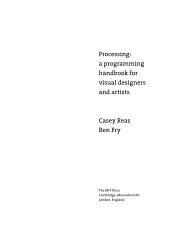Fractal.Invaders, Substrate (Interview with Jared Tarbell) - Processing
Fractal.Invaders, Substrate (Interview with Jared Tarbell) - Processing
Fractal.Invaders, Substrate (Interview with Jared Tarbell) - Processing
You also want an ePaper? Increase the reach of your titles
YUMPU automatically turns print PDFs into web optimized ePapers that Google loves.
trajectories in 2D space. EyesWeb’s extensive vision affordances make it highly<br />
recommended for students.<br />
The most sophisticated toolkits for computer vision generally demand greater<br />
familiarity <strong>with</strong> digital signal processing, and they require developers to program in<br />
compiled languages like C++ rather than languages like Java, Lingo, or Max. The Intel<br />
Integrated Performance Primitives (IPP) library, for example, is among the most general<br />
commercial solutions available for computers <strong>with</strong> Intel-based CPUs. The OpenCV<br />
library, by contrast, is a free, open source toolkit <strong>with</strong> nearly similar capabilities and a<br />
tighter focus on commonplace computer vision tasks. The capabilities of these tools, as<br />
well as all of those mentioned above, are continually evolving.<br />
<strong>Processing</strong> includes a basic video library that handles getting pixel information<br />
from a camera or movie fi le as demonstrated in the examples included <strong>with</strong> this text.<br />
The computer vision capabilities of <strong>Processing</strong> are extended by libraries like Myron,<br />
which handles video input and has basic image processing capabilities. Other libraries<br />
connect <strong>Processing</strong> to EyesWeb and OpenCV. They can be found on the libraries page of<br />
the <strong>Processing</strong> website: www.processing.org/reference/libraries.<br />
Conclusion<br />
Computer vision algorithms are increasingly used in interactive and other computerbased<br />
artworks to track people’s activities. Techniques exist that can create real-time<br />
reports about people’s identities, locations, gestural movements, facial expressions, gait<br />
characteristics, gaze directions, and other attributes. Although the implementation of<br />
some vision algorithms requires advanced understanding of image processing and<br />
statistics, a number of widely used and highly effective techniques can be implemented<br />
by novice programmers in as little as an afternoon. For artists and designers who are<br />
familiar <strong>with</strong> popular multimedia authoring systems like Macromedia Director and<br />
Max/MSP/Jitter, a wide range of free and commercial toolkits are also available that<br />
provide ready access to more advanced vision functionalities.<br />
Since the reliability of computer vision algorithms is limited according to the<br />
quality of the incoming video scene and the defi nition of a scene’s quality is determined<br />
by the specifi c algorithms that are used to analyze it, students approaching computer<br />
vision for the fi rst time are encouraged to apply as much effort to optimizing their<br />
physical scenario as they do their software code. In many cases, a cleverly designed<br />
physical environment can permit the tracking of phenomena that might otherwise<br />
require much more sophisticated software. As computers and video hardware become<br />
more available, and software-authoring tools continue to improve, we can expect to see<br />
the use of computer vision techniques increasingly incorporated into media-art<br />
education and into the creation of games, artworks, and many other applications.<br />
Notes<br />
1. http://mechanism.ucsd.edu/~bill/research/mercier/2ndlecture.pdf.<br />
2. http://www.fundacion.telefonica.com/at/rlh/eproyecto.html.<br />
555 Extension 3: Vision



